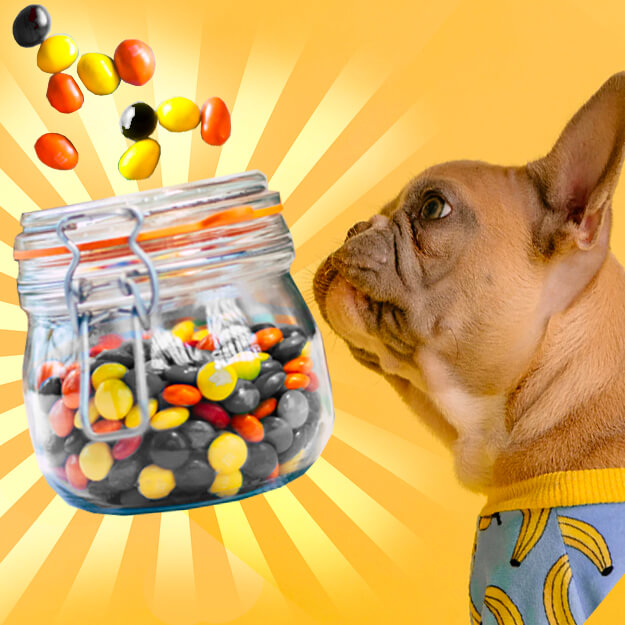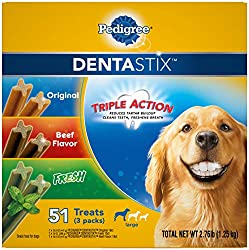
Can dogs eat Reese’s Pieces? Yes, dogs can eat a few Reese’s Pieces since this occasional treat does not contain ingredients that are toxic to dogs such as raisins or chocolate. But we do not recommend that you give Reese’s Pieces to your pup because they are not healthy.
While savoring a handful of Reese’s Pieces and some peanut butter crackers, you notice your K9 friend eyeing the treats and wagging his tail, eager to have a bite.
You start to wonder, “Can my dog eat Reese’s Pieces?” Before you hand over some of your Reese’s Pieces treat, you’ll want to read this article first. We’ve also provided a list of healthy and nutritious dog-friendly treats to give your pups instead.
Table of Contents
Can dogs have Reese’s Pieces?
Ideally, your dogs should not have Reese’s Pieces because these candies contain ingredients that are not suitable for canines. However, if you’re offering a few Reese’s Pieces as a rare occasional treat, then that should be fine.
This is because Reese’s Pieces have a high sugar content, which can lead to obesity, dental issues, and diabetes in dogs.
Peanut is another main ingredient which may be harmful to dogs with peanut allergies.
Also, the artificial flavors and colors, along with salt and milk, can also be problematic for our canine friends, as they may cause gastrointestinal upset or exacerbate food sensitivities.
So, what are the other ingredients in Reese’s Pieces that could potentially harm your furry friend’s health? Let’s take a look at that next. But first, let’s explore what Reese’s Pieces are.
What are Reese’s Pieces?
Reese’s Pieces is an American classic candy that was initially introduced to the US market in September of 1978. It wasn’t until later in 1980 when Reese’s Pieces was introduced to the Canadian market.
If you’re a big fan of E.T. the Extra-Terrestrial movie, you would know that this candy was featured in this movie in 1982. Reese’s Pieces became popular after the release of this movie.
Reese’s Pieces derived from the Reese’s Peanut Butter Cups line. These two candies are similar in that they both contain peanut butter as their main ingredient. They differ in that Reese’s Pieces do not have any chocolate.
Instead, this peanut butter candy comes in a flat circular shape and is covered in different color candy shells. It’s about the same size as a pumpkin seed and you’ll find them in three colors: orange, yellow, and brown.
But what are the ingredients in these Reese’s Pieces? Let’s get to it.
Ingredients in Reese’s Pieces
Here are the primary ingredients in Reese’s Pieces:
- Partially defatted Peanuts.
- Sugar.
- Corn syrup solids (Glucose syrup, a sweetener made from corn starch).
- Hydrogenated Vegetable oil which includes Soybean oil and Palm Kernel oil.
- Dextrose.
Each Reese’s Pieces has 2% or less of the following:
- Corn Syrup.
- Palm Kernel Oil.
- Salt.
- Confectioner’s glaze.
- Milk.
- Soy lecithin.
- Modified Cornstarch.
- Vanillin (Artificial flavor)
- Carnauba wax.
- Artificial flavors.
- Artificial colors (Yellow 6 Lake, Yellow 5 Lake, Red 40 Lake, Blue 1 Lake).
As you can see, Reese’s Pieces were made for human consumption. Some ingredients in this candy such as soy and peanuts can cause allergic reactions in dogs.
Let’s discuss each of these allergies in more details.
Dogs that are allergic to soy products may experience the following symptoms:
- Inflammation of the eyelids or blepharitis.
- Hair loss due to excessive licking of their fur and skin.
- Diarrhea.
- Vomiting.
- Have seborrhea in which they excessively discharge sebum.
- Ear infections.
Fortunately, most dogs are not allergic to peanuts. In fact, many dogs love the taste of peanut butter and it may be one of their favorite treats.
However, canines that have peanut allergies may experience mild to severe symptoms including:
- Bald spots due to excessive licking of their coat and skin.
- Difficulty breathing.
- Agitation.
- Itchy skin causing your pup to scratch frequently.
- Red skin from the regular scratching.
We’ll further discuss peanut allergies below.
If you must share Reese’s Pieces with your furry friends or falls for their puppy dog eyes, be sure to break the round candy into smaller pieces and make sure there are no sharp edges. It’s best to give them one or two pieces of Reese’s Pieces and see how they react.
If they react, do not give them any more Reese’s Pieces candy, and visit your vet right away to see if your pooch needs any immediate treatments. If they are fine, only give them as an occasional treat once a month or once every few months.
How to know if my dog has peanut butter allergies?
If your four-legged pup is allergic to peanut butter, you’ll know right away. Many dogs will have mild, moderate, and severe allergies to peanut butter very quickly after they’ve consumed it.
You’ll see the following symptoms of peanut butter allergies in dogs:
- Vomiting.
- Sudden diarrhea.
- Excessive licking of their skin.
- Drooling excessively.
- Red skin or itchy skin.
- Hotspots.
- Fast heartbeat and heart rate.
- Agitation.
- Pulse is weaker.
- Bald spots.
- Difficulty breathing.
Note that there are two types of peanut butter allergies in dogs. They are:
- Internal bodily reactions.
- Skin allergies or atopic dermatitis.
Dogs that are experiencing the most severe case of an allergic reaction will likely go into an anaphylactic shock. Bring your precious pooch to your vet immediately. Your vet will most likely inject your pup with a dose of adrenaline.
The good news is that treatments are generally successful and your furry friends will recover fully. Your vet may also prescribe EpiPen or allergy medications in the event that this may happen again.
What happens if my dog eats too much Reese’s Pieces?

If your dog accidentally ate too many Reese’s Pieces, they are at risk of excessive fat and sugar consumption. Let’s take a look at the nutritional profile of a single piece of Reese’s Pieces:
Nutritional Profile of Reese’s Pieces (Per Piece)
| Name, Unit | Amount |
| Calories, cal | 3.9 |
| Sugar, g | 0.41 |
| Sodium, mg | 0.88 |
| Carbohydrate, g | 0.49 |
| Total Fat, g | 0.18 |
| Saturated Fat, g | 0.16 |
| Protein, g | 0.08 |
| Fiber, g | 0.02 |
| Iron, mg | 0.72 |
This means a single piece of Reese’s Pieces has about 4 calories, 0.18 grams of fat (0.16 grams saturated), and 0.49 grams of carbohydrate (0.41 grams of sugar).
So in one piece of Reese’s Pieces, 80% is sugar and fat. If your dog eats this candy, it is like eating raw sugar and fat. Eating one or two pieces of Reese’s Pieces is fine for a dog, but since this candy is very small and colorful, a dog can accidentally consume a lot of it when you’re not watching.
Be sure to keep your Reese’s Pieces plastic packets on a high shelf, out of sight, or in an area where your canine pooch can’t reach them. If it’s within their reach, your furry companion can accidentally eat the whole packet. This can be deadly as the amount of sugar, fat, and calories absorbed into their system can lead to both long-term or immediate consequences.
Some immediate consequences include vomiting, diarrhea, constipation, or abdominal pain and bloating because your canine may have most likely suffered from GI distress.
Additionally, eating too many Reese’s Pieces or eating them every day can lead to diseases such as diabetes, obesity, heart disease, and even pancreatitis. Let’s dive deeper into each of these consequences.
Danger of sugar in Reese’s Pieces
Since one piece of Reese’s Pieces has over 50% sugar content, it’s already too much sugar for your pooch. A dog does not need that much sugar intake and eating too much of this candy can cause several gastrointestinal issues immediately.
First, your pup may experience stomach issues such as diarrhea and vomiting because the excess sugar (that your pooch doesn’t need) is withdrawing water out from your dog’s body and transferring it all into your dog’s intestines. Your canine companion may have digestive tract issues and become dehydrated.
Second, your pooch may start to gain weight.
Reese’s Pieces should be an occasional treat and not something you give your pup every day. If you give them to your pup every day, their body will have a high-fat percentage and this can lead to problems like obesity, diabetes, and metabolic issues.
Keep in mind that your dog’s health could slowly become worse as one health condition could lead to another health issue. Instead of healthy muscles, your dog’s body will have a high fat composition, which can weigh them down leading to joint problems, lack of exercise, and not motivated to move around.
Third, your canine companion may experience tooth decay. According to Brandywine Valley, 80% of dogs have periodontal disease or dental disease by 3 years of age so giving your dog more sugar will not help this problem.
The bacteria in your canine’s mouth will use the sugar as fuel to make corrosive acids. This type of destructive acid is able to remove the coating and enamel from your dog’s teeth. Over time, this leads to tooth decay and cavities. Yikes!
Instead of giving your dog Reese’s Pieces, there are healthier, canine-friendly alternatives. It’s better to opt for healthier snacks like Brussel Sprouts that have the same texture as Reese’s Pieces but much crunchier and flavorful.
However, we understand that some dogs may not like vegetables. Our Labrador can not stand veggies so we give her this Dentastix treat, which is great for her teeth and breath.
Now let’s talk about the fat content in these Reese’s Pieces.
Danger of fat in Reese’s Pieces
Although dogs require a certain amount of fat in their diet as macronutrients to help with brain operation and maintaining healthy skin, coat, and eyes, too much fat consumption can lead to an increase in fatty tissue.
In fact, according to the National Academy of Sciences, a 33-pound dog should only consume 14 grams of fat a day.
This will cause the dog to gain unwanted weight. What’s dangerous is that the fatty tissue will put pressure on your dog’s joints and bones as well as internal organs, which will affect their body and organ functions.
Over time, similar to the dangers of sugar, having a high-fat percentage in their body can lead to heart disease, obesity, and diabetes. In fact, your pup can develop acute pancreatitis if he is consuming a large amount of food with high-fat content in a short time period.
Having acute pancreatitis is serious because the quick intake of fat causes the pancreas to become inflamed suddenly and eventually the pancreas will break down internally.
Here are some of the symptoms of pancreatitis:
- Lethargy.
- Abdominal pain.
- Vomiting.
- Hunched over or bent over in pain.
- Fever.
If you see any of these symptoms, visit your vet right away so your precious pooch can be treated early before it becomes a life-threatening situation and the pancreas deteriorate even more. Early detection means treating the problems sooner and allow your dog to recover from pancreatitis.
If it is life-threatening, your dog’s vet will most likely prescribed IV fluids, anti-inflammatory medications, and painkillers to save your pup’s life.
Can you feed Reese’s Pieces to your dog if they are past their best-by-date?
Yes, but we do not recommend feeding your dog Reese’s Pieces that are past their best-by-date just like you wouldn’t eat expired food. Since Reece’s Pieces are filled with sugar, they generally have a long shelf-life. Reese’s Pieces past their best-by-date will change in flavor and texture.
To dogs, they won’t know and they will not care. But as a responsible dog owner, it’s best not to give our pooch anything past their best-by-date.
What can I do if my dog ate too many Reese’s Pieces?
First, you should not induce vomiting if your dog ate too many Reese’s Pieces. Doing so can actually harm your pup. If you suspect or know that your canine has consumed several packets or servings of Reese’s Pieces, call or visit your vet as soon as you can.
Your pup’s vet will give you instructions on what is the best approach. If they recommend that throwing up is the best approach, they may ask that you use 3% hydrogen peroxide at a dose of 1 teaspoon per 5 pounds of body weight so your pooch can throw up.
Generally, put all the Reese’s Pieces away and make sure your furry friend drinks a lot of water and not eat anything else for the rest of the day. Allow your dog to fast if he is having diarrhea or vomiting.
So, Can dogs eat Reese’s Pieces?
Dogs can eat Reese’s Pieces, but only a few pieces. Specifically, it’s best to just eat 1, 2 or 3 at most. This candy is small and colorful for dogs so they can easily consume the whole bag if they can. However, Reese’s Pieces contain a high fat and sugar content, which can cause sudden health issues and lead to diarrhea, vomiting, or even acute pancreatitis.
Over the long term, your dog will experience dental problems like tooth decay and gain unwanted weight, have diabetes and heart disease.
So the next time you fall for their puppy dog eyes, think again and give them a few as an occasional treat.
DISCLAIMER: THIS WEBSITE DOES NOT PROVIDE MEDICAL ADVICE
The information, including but not limited to, text, graphics, images and other material contained on this website are for informational purposes only. No material on this site is intended to be a substitute for professional veterinary advice, diagnosis, or treatment. Always seek the advice of your veterinarian or other qualified health care provider with any questions you may have regarding dietary needs.
Resources:
https://vcahospitals.com/know-your-pet/dental-disease-in-dogs
https://www.akc.org/expert-advice/health/diabetes-in-dogs/

With over five years of specialized experience as an animal writer, my expertise lies in dog nutrition, health, behavior, grooming, and training. I am dedicated to delivering helpful and informative content that caters to the well-being of our furry friends. My primary goal is to empower pet owners with knowledge and ensure our canine companions thrive in health and happiness. In my free time, I love volunteering at local dog rescue centers.









